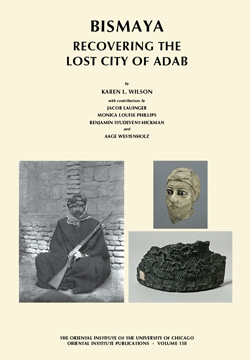OIP 138. Bismaya: Recovering the Lost City of Adab

Karen Wilson, with Jacob Lauinger, Monica Louise Phillips, Benjamin Studevent-Hickman, and Aage Westenholz
Purchase Download Terms of Use
An expedition from the University of Chicago excavated the site of Bismaya (ancient Adab) from December 24, 1903, until late June 1905. The excavations were directed first by Edgar J. Banks and then, briefly, by Victor S. Persons. Over 1,000 artifacts, many of them early cuneiform documents, were sent to Chicago, where they are now housed in the Oriental Institute Museum.
The results of the Bismaya excavations were never properly published, and most of the material was never published at all. Banks wrote a lively and highly readable popular account, Bismya, or the Lost City of Adab, that appeared in 1912 and gave the impression that his field methods were considerably less than satisfactory. However, that was not the case. Banks kept a careful field diary, complete with highly accurate sketches, and sent detailed weekly reports, lavishly illustrated with his own drawings, back to Chicago. These materials show that he excavated a mid-third-millennium BC temple and discovered some of the world’ s first historical inscriptions incised on stone vessels dedicated in that structure. He also uncovered residences of the late Early Dynastic period, two Akkadian administrative centers, and a palace of the Isin Larsa/Old Babylonian period.
This monograph presents this large and significant corpus of unpublished material and includes analyses of stratigraphy, architecture, sculpture, cylinder seals, metalwork, and pottery, and discussions of chronology, the succession of the first kings of Adab, and administrative practices during the third millennium BC.
Table Of Contents:
- Chapter 1. A Note on the Sources
- Chapter 2. Early Exploration
- Chapter 3. The University of Chicago Expedition to Bismaya and “the Oldest Statue in the World”
- Chapter 4. The Site, the City, and the City Wall
- Chapter 5. Mound I — “The Palace”: A Palace of the Isin-Larsa/Old Babylonian Period
- Chapter 6. Mound II — “The Cemetery”: Residence(s) of the Late Early Dynastic Period and Remains of the Isin-Larsa/Old Babylonian Period
- Chapter 7. Mound III — “The Semitic Quarter”: An Akkadian Administrative and Light Industrial Complex
- Chapter 8. Mound IV — “The Library”: An Administrative Center During the Reign of Sharkalisharri
- Chapter 9. Mound V — “The Temple”: A Series of Temples of the Third Millennium B.C.
- Chapter 10. Mound X — Residences of the Akkadian Period?
- Chapter 11. The Remaining Mounds
- Chapter 12. Objects Whose Findspots Could Not Be Determined
- Chapter 13. Objects Purchased by the Expedition
- Chapter 14. Archaeology and the History of Bismaya
- Appendix A. Early Dynastic Tablets from Adab in the Collection of the Oriental Institute Museum. Monica Louise Phillips
- Appendix B. The Ur III Administrative Tablets from Adab in the Collection of the Oriental Institute Museum. Benjamin Studevent-Hickman
- Appendix C. The Old Babylonian Tablets from Adab in the Collection of the Oriental Institute Museum. Jacob Lauinger
- Appendix D. A7447 — The Inscription. Aage Westenholz
- Appendix E. Objects from Bismaya Now in the Collection of the Eski Sark Museum, Istanbul
- Appendix F. List of Objects by Oriental Institute Museum Number
- Appendix G. Bibliography of Works by Edgar J. Banks
- Plates
- Oriental Institute Publications 138
- ISBN: 9781885923639
- Chicago: The Oriental Institute of the University of Chicago, 2012
- Pp. xxx + 194; 47 figures, 113 plates, 13 tables
- $80.00

